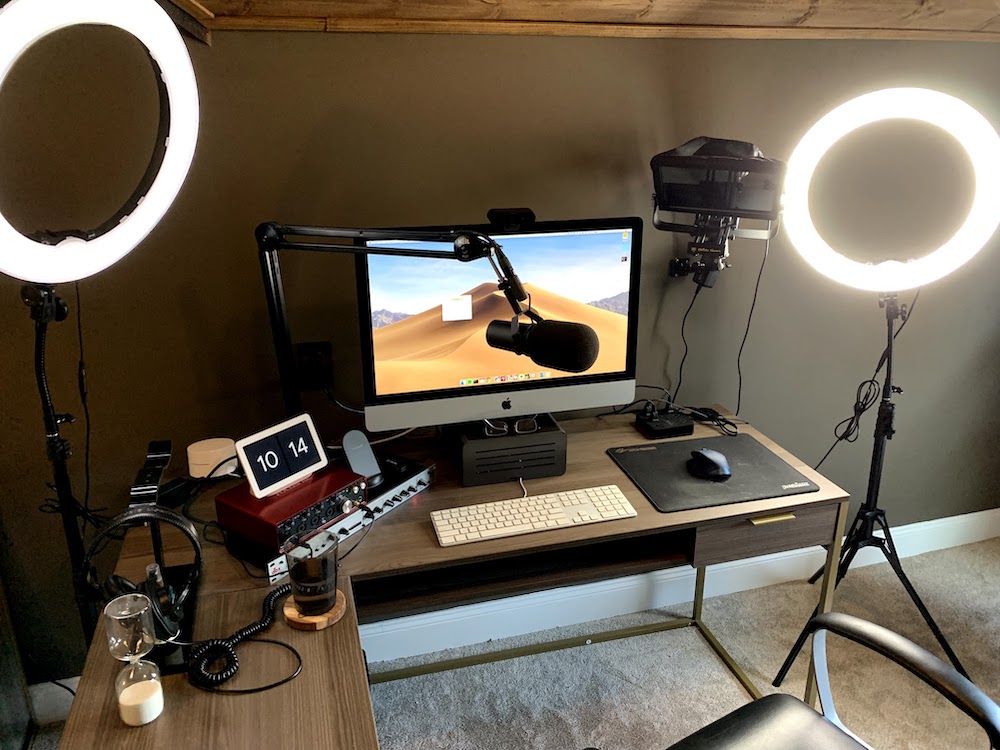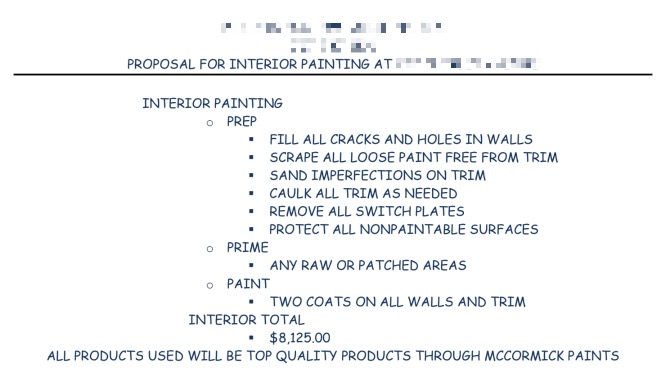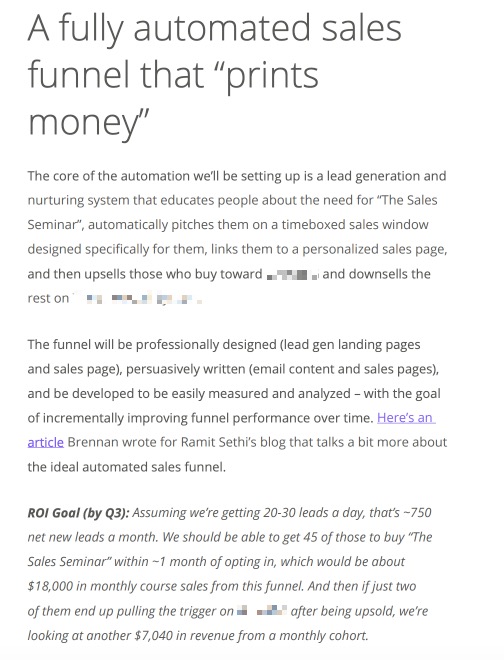This year I probably bit off more than I could chew.
I’ve been sharing a lot of it over Twitter, but to sum things up:
- Bought a new house, closed on January 2
- Because this was an upgrade in square footage, we did the (stupid) thing and rushed to fill in the blanks with new furniture, etc.
- The house is 100 years old, and was built in a time when attics were built super well. I’m talking high, old growth beams and space. Decided to convert it into a swank home office.
I’m juggling the running of two different companies: Double Your Freelancing (👋) and RightMessage. My days are already jam packed.
So a “let’s hire a ton of contractors to redo the attic” project – while essential, considering I was spending my days hunched over a MacBook in the dining room – probably wasn’t all that smart of a move to make. Especially while the proverbial dust was still settling in the new house.
But we did it. And check out how bad ass my desk area turned out:

(Noticed how little new content I’ve sent out this year? YEP. Distractions.)
OK, so what does my home renovation have to do with your consulting business?
Over the last few months, I’ve worked with:
- A carpenter to handle all the framing of the attic and build the custom shelving
- An electrician to run the wiring and setup the lighting
- A drywall guy
- An HVAC company to help me avoid summer heat stroke
- A painter to… paint
- A carpeting company to get the flooring down
Every contractor I worked with priced pretty much the same way. They’d come over, check out the space and do some measurements, and then later would send me a quote.
The proposals were pretty much all setup the same way. “Here’s what we’ll do, and here’s what it will cost.”

Many freelancers – especially those who haven’t been doing it that long – take a similar approach to quoting their projects. They ask the client what they want, guesstimate how long it’ll take them to do it, and then throw over the wall a proposal that lists out a bunch of deliverables with time estimates, ultimately multiplied by an hourly rate.
This makes a lot of sense if you’re a painter. You look at what you’ve got to paint, estimate how much supply you’ll need, and then estimate how long it’ll take your team to do the work. Tack on some labor and material markup, and that’s what you charge.
But unless the work you do is very turnkey (which it shouldn’t be), then you owe it to yourself and your clients not to estimate and price your work like a painter.
How come?
A few years ago, I was working on my first video course. This was something brand new to me – I knew zilch about filming and editing.
So I asked around. A bunch of local videographers were willing to show up with their gear, film me, and then edit. They were all pretty much in the same ballpark, and I ended up sitting on a mountain of quotes.
And then someone from my audience emailed me. His name’s David, and he told me a story about what was possible with the right video course. I was hooked. And in the end, I paid him substantially more than every other person I was talking with.
Let’s deconstruct why I paid David 10x more (hint: it has nothing to do with money!)
Sell a story
Rather than just coming up with a laundry list of requirements, you’re going to pitch a narrative.
How people buy the kind of creative consulting you want to sell isn’t the same as they buy painting services.
When you’re hiring a painter, you’re basically saying something like: “I have four walls in this room, and somebody needs to get paint on them. What will you charge me to do the work?”
The scope is pretty defined. Four walls. Four hundred square feet of space. Nine foot high walls. There’s not much room for creativity here.
Yet with consulting, there’s a good chance the room isn’t yet defined. And even if the client believes they know what needs to be done, that doesn’t really mean much. A great consultant isn’t going to just ask what needs to be done; rather, they’re going to focus on what needs to be achieved.
There’s a difference. A big one.
An achievement is the realization, or attainment, of a goal. It’s successfully reaching Point B after setting out from Point A. There’s not one right way to reach a goal.
But there is only one way to paint a room (for the most part.) The outcome will largely be the same: a painted room.
When I client says “I need a video course created”, savvy consultants are going to see that requirement as a goal rather than an instruction.
After all of the local videographers heard that I needed a video course, they figured I just needed someone to show up with a bunch of gear, hit the record button, and then stitch a final set of videos together.
But David saw my needs differently than the rest. He asked me why I wanted this video course created. Who would it be sold to? What would it help them with? Where would the course fit within my overall business?
He knew that my four walls weren’t defined. I didn’t want a video course for any reason outside of a belief that it would add a level of professionalism that my business didn’t have at the time. I wanted a particular outcome, and he jumped on that.
Let’s look at what the four traits of a perfect proposal are:
Perfect Proposal Trait #1: Empathy
To sell a great story, you first need to show some empathy: “I understand where you are now, and I know how this is holding you back.”
I can’t stress how important it is to show your clients that you understand them.
This is the single biggest way to reduce risk. It even trumps a moneyback guarantee. If a client believes that you know exactly what’s at stake, they’re going to think that you have a good idea of both what needs to be done – and what shouldn’t be done.
While a moneyback guarantee might help a client think you’re low risk because there’s no financial risk, they’re still risking their own time and opportunity in doing potentially the wrong thing – two resources that can never be recovered. That’s why it’s so important for your clients to know that you really “get” them.
Perfect Proposal Trait #2: We’re going to get to the promised land – together
After making it crystal clear that you understand exactly where they are today, warts and all, the next step is to paint them a picture of a better tomorrow.
Look at this future David described to me:
“I’m excited about the video course, but first, this: you’re a part of the small tribe in the world that truly knows and expects high-quality work. Judging by your blog’s design and content, your course (that I just purchased yesterday— super pumped), and your emails, it’s obvious that you are intentional about giving and doing your best.
I know you’ve seen some of your acquaintances’ videos or courses that they’ve produced, and you can really tell that, eh, they really tried, but it really didn’t impress. The differences between those kinds of videos and videos that you were blown away by are surprisingly few by number. There are certain small elements that, if done correctly, take the distractions away and engage and focus the viewer straight into the content. These small elements contribute to a stellar, exciting, first-rate (not ordinary, boring, amateur, or familiar) product.
This is important, because I really need for your students to see and discern something: beyond what’s coming out of your mouth, what your hand gestures are relaying, or how great the screencasts are, your students really need to see your heart.
You see, the passion that you have comes out of an amazing, rare desire to simply help. This character trait, a humble helper, oozes out of every email and blog post that you write, and should also ooze out the videos that you produce. The reason that you are successful is because people realize that you are there to help. You’re helping to build better businesses and better lives as a result.
Here’s why I’m excited: we’re going to be a great team in making this project a success because we both have a vision for quality and excellence, and we both want to help the world succeed. There’s no way that this isn’t going to turn out to be fantastic.”
I was floored.
This was so much different than everything else I was getting. Proposals listing off gear, equipment, man hours, and so on. Stuff that I frankly didn’t know or care enough about – I just wanted what David was getting at.
Perfect Proposal Trait #3: How big of a deal is this?
You want to make it clear to your clients that you have a plan for how hiring you will yield some sort of financial return.
(Remember, no matter who’s footing the bill, somebody is on the hook for ensuring that whatever work you do is going to add some material benefit to their business.)
You’re going to want to make sure that you’re spelling out what your plan is for aligning your deliverables with a desired outcome. If you’re Roadmapping, coming up with what this outcome is should be a no-brainer – it’s what you uncovered during your Roadmapping engagement.
I like to come up with three or four “big ideas” that package together a few things that I plan on doing, reiterating why they’re important, and then including an “ROI Goal” that, given the data I got from the client and combined with my own personal track record, projects out what’s possible.

“ROI Goal (by Q3): Assuming we’re getting 20-30 leads a day, that’s ~750 net new leads a month. We should be able to get 45 of those to buy “The Sales Seminar” within ~1 month of opting in, which would be about $18,000 in monthly course sales from this funnel. And then if just two of them end up pulling the trigger on XXXXXXXXXX after being upsold, we’re looking at another $7,040 in revenue from a monthly cohort.“
I realize that this isn’t as cut-and-dry for some as it is for me. If you’re not sure how you’d go about quantifying ROI goals for the sort of projects you work on, check out this article I wrote on quantifying project value.
No matter the project, long before any of my own costs are shown I’m making it a point to showcase what wins I’m going to do my best to deliver, all the while backing up any projections I make using real-world data that was shared. (A good crash course on how to get this data is found in my flagship course, Double Your Freelancing Rate)
Perfect Proposal Trait #4: A well-anchored cost
This might surprise you, but putting a price tag on a project is the most straightforward part of this process.
Why?
Because once you’ve told a compelling story and pointed out 3-4 big ideas (and their associated ROIs), you’re going to be able to come in and offer a price (or prices, should you package – which you should) that works for you and makes financial sense to them.
When David quoted me, he had an idea of what I was planning on selling the course for and could reduce down his premium to: “imagine how many more sales and referrals a better course would bring?” Ultimately, he convinced me to see his premium in terms of “number of additional courses sold” instead of hard dollars and cents.
Likewise, for the proposal I sent in the above section, I had a very solid understanding of what was at stake:
- I knew how the client was currently generating revenue
- I had a pretty strong understanding of their current deficiencies, and could superimpose my own experience onto their business model and come up with pretty accurate projections
- I understood how their current model / business processes were holding them materially back
All of this came from Roadmapping done right.
So when I listed a few cost options, all of them came out way under what the potential financial upside of the project was projected to be. I was an investment. I was selling “pay me $X and I’ll give you Y.” (This is called value-anchoring.)
All free of fluff and hocus-pocus.
If you’re selling yourself like a painter, and estimating out how much time it’ll take you to complete a project and then multiplying that time estimate by an hourly rate, I’d seriously encourage you to ditch your line-item quotes and move toward selling a story.